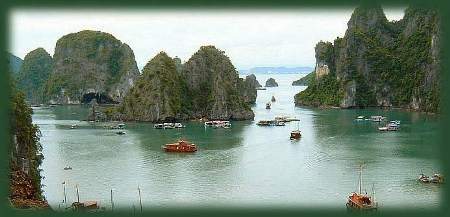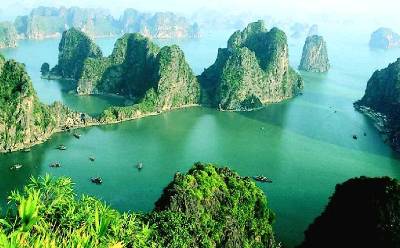
THE NATURE WORLD HERITAGE – HA LONG BAY
Ha Long Bay is
located in northeastern Vietnam.
The bay stretches from Yen Hung district, past Ha Long city, Cam Pha town to Van
Don district, bordered on the south and southeast by the Gulf
of Tonkin, on the north by China,
and on the west and southwest by Cat Ba island. The bay has a 120km long
coastline and is approximately 1,553km² in size with about 2000 islets. The
area designated by UNESCO as the World Natural Heritage Site incorporates
434km² with 775 islets, of which the core zone is delimited by 69 points: Dau
Go island on the west, Ba Ham lake on the south and Cong Tay island on the
east. The protected area is from the Cai Dam petrol store to Quang Hanh
commune, Cam Pha town and the surrounding zone.
 Panorama view of Halong Bay
Panorama view of Halong Bay
According to local
legend, when the Vietnamese were fighting Chinese invaders, the gods sent a
family of dragons to help defend the land. This family of dragons began
spitting out jewels and jade. These jewels turned into the islands and islets
dotting the bay, linking together to form a great wall against the invaders.
The people kept their land safe and formed what later became the country of Vietnam. After
that, dragons were interested in peaceful sightseeing of the earth, and then
decided to live here. The place where the mother dragon descended was named Ha
Long, the place where the dragon's children attended upon their mother was
called Bai Tu Long island (Bai: attend upon, Tu: children, Long: dragon), and
the place where the dragon's children wriggled their tails violently was called
Bach Long Vy island (Bach: white- colour of the foam made when Dragon's children
wriggled, Long: dragon, Vy: tail).